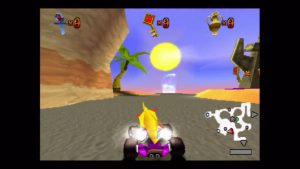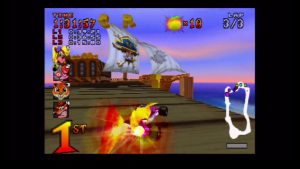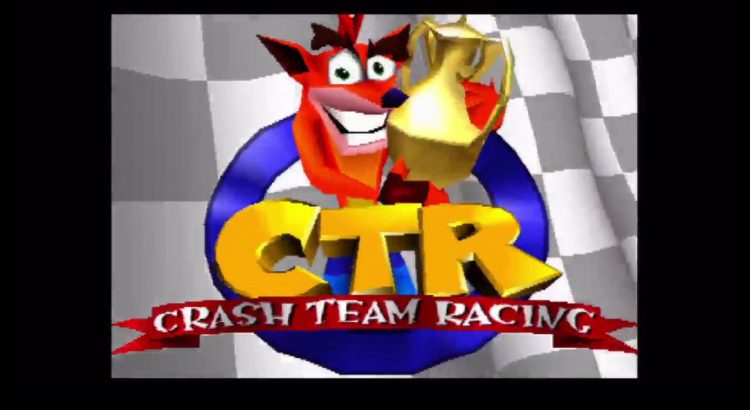I’ve been writing a lot about Nintendo a lot, and despite there being a reason for that (the overwhelming amount of design genius combined with controversial design choices give me A LOT to think about), I felt like making a post about something completely different. So today I will instead call back to my Playstation roots, to a particular game that to me still tops Mario Kart as one of my favorite karting games ever made: Crash Team Racing.
Before starting I want to provide some context about myself for a bit. For a lot of the late nineties, I was actually not playing a lot of what Nintendo offered due to lacking access to a Nintendo 64. Instead, what I did buy was a Sony Playstation, given that where I lived this meant easy access to games due to how easily Playstation games could be pirated outside of the United States. This was also back when distribution of said games was rare in South America. As a result, I was able to experience hundreds of Playstation games in very quick succession to each other. This is why this post gets to be about Crash Team Racing (CTR), the standout kart racer of the Playstation, and not about Diddy Kong Racing, a game that is structurally very similar and likely inspired a significant portion of single player choices.
Ultimately it’s these single player choices that push CTR to a level of quality most Mario Karts have failed to provide. It is also something I figure is interesting to talk about in a post following the one on Smash in which I spoke extensively about the quality of single player content in a multiplayer game. Then you have things like pretty much the rest of the game industry looking towards multiplayer as a primary focus, particularly in live services, which makes me even more keen to defend the single player experience.
Learning in a Competitive-free Environment
The first main case I’ll be building towards the importance of single player relates to how games work as a learning experience. The tradition of multiplayer games, with classics such as Go and Chess, is that the mechanics are simple to the point they just merit a simple explanation and then learning on the go while playing other players. The value of the game then arises from the joy of not just learning the meta-game, but also learning your opponent within a game in order to outplay them and reach success.
While multiplayer games within video games boast that same ability, the complexification of mechanics caused by greater availability of tools offsets the simplicity of this learning experience. I cannot expect to pick up a kart racer or a fighting game without prior experience, for example, without also expecting to get thoroughly defeated by more experienced players. So usually the new player will depend on the kindness of friends or family to guide them through the beginning steps, a process that assumes access to reliable and patient teachers.
It’s the first case for single-player in a multiplayer game: pacing and learning. By directing the player towards a single-player experience, you ensure as a designer that the first exposure a player has is appropriately simple to teach mechanics while avoiding early frustration.
In the case of CTR, the single player launches with admittedly slow storytelling that then drops the player in a hub world. The existence of the hub world allows the player to get used to the movement of the character they choose in a setting lacking consequences and stress. From here the game allows access to a variety of tracks for completion. The tracks themselves are organized and structured so that the easier stages are instantly visible, while more difficult tracks within that world are located more remotely, presumably to be found after the easier tasks have been completed.

The end result is that instead of forcing a player into an online contest or a championship gauntlet race that will most likely take about 15 minutes, the player is instead slowly introduced to the mechanics and the core of the game in a simple setting that is easily digestible. This is particularly beneficial in the context of kart racing games, which tend to be chaotic in nature and as such can risk frustration.
Going From Learning to Expertise
Another great bit from the single player in this game I personally always liked was the presence of area bosses to conclude a section of the overworld. Once a player has completed a race on every track, one of the bosses from the franchise challenges the player to a race and the player is placed in front of their game. Entering triggers a one versus one race against the boss. What makes this particularly brilliant is that the bosses are designed to not require weapons, and instead each has a specific item that they spam as much as possible. For example, the first boss Ripper Roo spams boxes of dynamite as he drives in front of the player. The last boss, N. Oxide, takes the extra evil step of starting before the player and dropping a large variety of items while racing on a significantly difficult track. Ultimately, while most of the nostalgia I have for this mechanic lies in hating the bosses and developing that emotional connection, the biggest praise I have for it is that it forces players to learn evasive maneuvers important in a kart racer.
When it comes to the individual tracks, CTR adds incentives that encourage further replayability and practice, much in the same way previous Crash games extend the life of each stage by adding collectibles. Relics, for example, are awarded for completing a track within specific times in a time trial challenge; mirroring how in Crash Bandicoot: Warped they were introduced to reward speedy players. Also like Warped, the game adds in timer boxes to add complexity and strategy to the challenge.
The one I find most interesting is the CTR token. Available in any stage, it can be obtained by not only winning the race, but also doing it while gathering the letters C, T and R. So what was previously a simple matter of completing a race becomes a struggle to learn where the letters are hidden while still outracing the competition. The brilliance of the matter is that the locations of the CTR letters are often shortcuts or secret passages that as a result extend the player’s knowledge of each individual track and by extension boost the capacity of the player to compete.

A last shout-out goes to the Crystal gathering challenges, which I had mostly forgotten about until replaying this game while preparing this post. In these, the player is placed in one of the battle arenas and asked to collect twenty crystals before the time expires. To make things interesting, some tracks add hazards like TNT or Nitro boxes that surround the crystals, and item boxes give you specific weapons to make the task easier. While initially I didn’t think much of this challenge as just an opportunity to practice driving more, I did have the learning moment while playing the game of figuring out how to use braking to improve maneuverability, which in turn just made me a better racer in other areas of the game. Once again, it goes back to the principle of using single player experiences to provide learning opportunities.
Single Player Focus Extends a Game’s Life and Impact
This section is one I keep wanting to address for games in general, not necessarily just CTR, though my recent playing experience with the game can certainly provide grounds for comparison.
It’s not unknown at this point that live service games are all the craze. The runaway success of competitive online games, with the likes of Rocket League, Overwatch, Player Unknown: Battlegrounds and now Fortnite commanding a significant amount of attention online. Ever since online gaming became a staple of what “gaming” is all about, more companies want to follow suit, and what we see as a result is games that are almost entirely focused on that online, competitive experience.
While this is a logical progression given where the industry is, I still find it incredibly short-sighted in terms of where a specific segment of gamers stands relative to the population as a whole. One of the core things I will constantly talk about is how different games work for different people for different reasons. Assuming that every player out there will have the will and capacity to have excellent online performance just for gaming, as a result, is short-sighted. For the most part, current live services work because they know exactly what their demographic is and what they are willing to do or pay. It makes sense for Overwatch, as a property of Activision Blizzard, to be heavily online-focused given the Blizzard demographic is likely to be invested in online-focused experiences.
The problem comes when everyone in the industry tries to copies these models without pondering whether it works for what they want to accomplish. Games like kart racers, or even things like Smash if we want to go back to thinking about that, are games that by virtue of their mechanics exist to welcome in new players and give them an opportunity to be engaged and have fun. Which is part of the beef I have with Mario Kart 8 Deluxe, where everything is unlocked instantly and there’s nearly no incentive to do anything single player. Sure, the game lives for multiplayer, particularly online, but especially considering it can also be a portable experience it’s a shame there’s no single player content to boost lifetime of the game for individual players or to provide the opportunities for learning I mentioned before.
Which leads to another consideration and further case for single player content: I was able, in 2018, to pick up CTR and play it on my own and still have a significant number of hours of fun. By giving this game a thorough single player experience, I wasn’t burdened by issues like other people not having the controllers, and since this was a pre-online game there’s no issue where I cannot play the game due to servers for it being dead. In the context of history, this means that CTR is a living game in the sense that anyone is able at any time to pick it up and actually play it. Compared to online-heavy games where they will be mostly dead the second servers for them stop existing or, in the case of peer-to-peer networking, the second the majority of players move on to the next big thing.
I won’t lie of course. With the revival of classic Crash Bandicoot platforming in the Crash N. Sane Trilogy, I am more than excited at the possibility of someone, anyone, re-mastering Crash Team Racing and releasing it on current consoles. More than anything because this would grant me the ability to race against other players in modern online competition. Nevertheless, a significant amount of the love I have for this game lies in the fact that I never needed other people to enjoy it, and I am grateful to the devs at Naughty Dog for ensuring that I could still enjoy their product in times when my gaming obsession wasn’t quite matched by other individuals around me. It makes me seriously hope that more developers pick up this lesson and engage players in single player experiences that revolve around actually learning the game better, and as a result open the world of gaming to people that might otherwise have considered themselves “not good enough” to play with others.
Stray Notes
- Shoutout to the March 8th, 2018 Nintendo Direct for significantly distracting me from working on this post. I do love that following a post heavily speculating on the future of Smash we got a teaser that now has everyone heavily speculating on the future of Smash.
- The desire to replay and capture footage of CTR led me to discover that the PlayStation 4 does NOT have playstation classics in its store or network. Despite the PS3 having them. Don’t know if I’ll go extensively enough into this to make a post, but it bothers me that game availability and distribution is still an issue in 2018.
- It makes me sad that this was the last Crash game Naughty Dog worked on. It’s great for them in that they followed up with success after success, but man did they knock it out of the park with their four Crash games.
- While preparing for this post I asked a lot of people who enjoyed Diddy Kong Racing why they enjoyed it so much. Single player content was by far what I heard about the most. I seriously hope I get to play this title and compare it to the effect CTR has on my nostalgia.
- This has nothing to do with single player specifically, but I love that this game features the mechanic of boosts following particularly high jumps. It gives the game a great sense of speed and momentum, particularly in tracks like Tiny Arena and Polar Pass.
